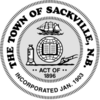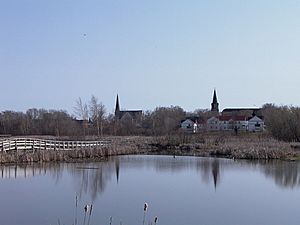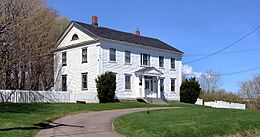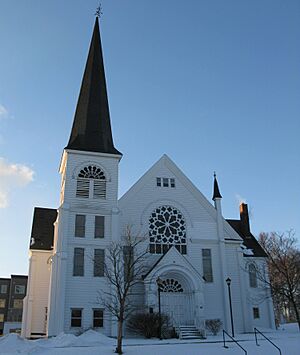Sackville, New Brunswick facts for kids
Quick facts for kids
Sackville
|
||
|---|---|---|
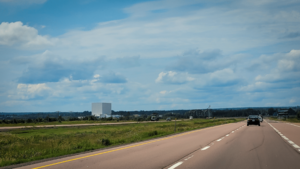
Sackville on the Tantramar Marshes
|
||
|
||
| Motto(s):
A different kind of small town
|
||
| Country | Canada | |
| Province | New Brunswick | |
| County | Westmorland | |
| Parish | Sackville Parish | |
| Town | Tantramar | |
| Established | 1762 | |
| Incorporated | January 4, 1903 (as Town of Sackville) | |
| Amalgamated | January 1, 2023 (into Town of Tantramar) | |
| Federal electoral district | Beauséjour | |
| Provincial electoral district | Memramcook-Tantramar | |
| Area | ||
| • Land | 73.91 km2 (28.54 sq mi) | |
| Elevation | Sea level to 32 m (0 to 105 ft) | |
| Population
(2021)
|
||
| • Total | 6,099 | |
| • Density | 82.5/km2 (214/sq mi) | |
| • Change (2016–21) | ||
| Demonym(s) | Sackvillian | |
| Time zone | UTC-4 (Atlantic (AST)) | |
| • Summer (DST) | UTC-3 (ADT) | |
| Canadian Postal code |
E4L
|
|
| Area code(s) | 506 | |
| Telephone Exchange | 360, 364, 536, 540, 939, 940 | |
| NTS Map | 21H16 Amherst | |
| GNBC Code | DAEAM | |
Sackville is a community in southeastern New Brunswick, Canada. It used to be a town on its own. Since 2023, it is part of the larger town of Tantramar.
Sackville is famous for being home to Mount Allison University. This university is known as a top school for liberal arts studies in Canada. About 2200 students attend each year. In the past, Sackville's economy relied on farming, building ships, and making things. Today, the university and tourism are the main drivers of its economy. Sackville was first part of the French colony of Acadia. After 1755, it became part of the British colony of Nova Scotia. This happened after many Acadians were forced to leave their homes.
Contents
- Sackville's Past: A Journey Through Time
- Sackville's Geography and Natural Beauty
- Important Buildings and Services
- People of Sackville: Demographics
- Sackville's Economy
- Arts and Culture in Sackville
- Cool Places to See in Sackville: Landmarks
- Learning in Sackville: Education
- Sackville Public Library
- Media in Sackville
Sackville's Past: A Journey Through Time
Early Days: Before Europeans Arrived
The area where Sackville is now was once part of the Mi’kmaq district called Siknikt. This area included parts of what are now Cumberland, Westmorland, and Albert counties. The Mi’kmaq people had settlements here. Many local place names, like Tidnish and Memramcook, come from the Mi’kmaq language. An important travel route connected this area to other parts of Acadia and Quebec.
French Colony: Acadians Settle Here (1670s-1755)
The first Acadians came to this area in the early 1670s. They were part of the growing French colony. Many Acadians knew how to reclaim land from the sea. The Tantramar Marshes were perfect for this. The Acadians built special walls called dykes and gates called sluices. These helped them farm the marshlands. By 1748, there were several Acadian settlements in the area. They had a total population of about 3,000 people. A seaport at Westcock connected them to other places.
British Takeover and New Settlers
In 1713, the Treaty of Utrecht gave Acadia to England. But the border between French and British lands was not clear. This led to small fights. In 1755, the French were defeated at the Battle of Beausejour. This meant most French soldiers left Acadia. Soon after, the British decided to remove all Acadians from the area. This was the start of the expulsion of the Acadians. They could only take their money and furniture. Their homes were burned down.
After the Acadians left, the British wanted new people to live in the colony. They invited settlers from New England with land grants. In 1761, 25 families from Rhode Island moved onto the empty Acadian farms. More settlers came in 1763. By 1767, most of the people were Americans. The Sackville Township was officially created in 1765. It was named after Viscount Sackville.
From 1772 to 1775, many people from Yorkshire, England, also came. They bought land from New Englanders who did not stay. During the American War of Independence in 1775, some American settlers supported the rebels. But the Yorkshire settlers stayed loyal to the British. After the war, United Empire Loyalists moved north to the Sackville area. By 1786, there were 60 families living there.
Growth and Shipbuilding
By the 1830s, businesses like tanneries (for leather), carriage factories, and blacksmith shops were busy. These were located near Morice Mill Pond (now Silver Lake). The town centre then moved to its current spot. This happened when William Crane moved his business there in 1836. He also helped build a Methodist church. In 1839, Charles Frederick Allison gave money and land to start the Mount Allison Wesleyan Academy. This school later became Mount Allison University.
Shipbuilding also grew along the Tantramar River. Records show shipbuilding was active by 1824. By 1862, there were shipyards near the current railway station. Merchants built a public wharf in 1840–41 to import and export goods. Shipbuilding was very successful between 1824 and 1872. The largest ship, the Sarah Dixon, was built in 1856. Another ship, The Westmorland, carried passengers and mail.
Over time, the wharf became too small for larger ships. A new wharf was built in 1911, but much of the shipping business had already been lost. Later, the river changed its path, leaving the wharf without access to the sea.
The Railway Era Transforms Sackville
In 1872, the Intercolonial Railway project brought big changes to Sackville. The railway line was planned to go through the area. This led to the commercial centre of Sackville moving closer to the railway line. The New Brunswick and Prince Edward Island Railway was built later. It connected Cape Tormentine (the closest point to Prince Edward Island) with the main railway line. Sackville was chosen as the connection point thanks to local businessman Josiah Wood.
In the 1870s and 1880s, many industries came to Sackville. This was due to a government plan called the National Policy. Sackville became home to two foundries: Enterprise Foundry and Fawcett Foundry. They both made stoves and similar products for over a century. These companies later merged. The Fawcett Foundry closed, and its site is now part of Mount Allison University. The Enterprise-Fawcett Foundry was one of the last stove foundries in the world. It was damaged by fire in 2012 and has not been rebuilt.
Sackville became an important railway hub. The railway yard and station were very busy. But after World War II, new highways were built. This led to a slow decline in railway use. When the railway line to Prince Edward Island closed in 1989, more businesses left Sackville.
Recent History
On January 1, 2023, Sackville joined with the village of Dorchester and other local areas. They formed the new town of Tantramar. Sackville's name is still used for the community.
In November 2022, Sackville was named an international wetland city under the Ramsar Convention. It was the first city in North America to receive this honor.
Sackville's Geography and Natural Beauty
Sackville is located on the Isthmus of Chignecto. This narrow strip of land connects the Nova Scotia peninsula to North America. The town is on the Tantramar River, which flows into Chignecto Bay. This bay is part of the Bay of Fundy. Sackville is very close to sea level. Tall ridges rise above the surrounding marshes.
The Tantramar Marshes are a key feature of the area. They were once tidal saltmarshes. These marshes are a vital stopover point for migrating birds. The soil in the marshes is made of silt from centuries of tidal flooding. The area has slow-moving rivers, shallow lakes, bogs, and intertidal zones.
Important Buildings and Services
The main highway, the Trans-Canada Highway, used to go right through Sackville. A bypass was built in 1962. This highway is one of the main roads connecting New Brunswick and Nova Scotia. CN Rail's main line also runs through Sackville. The Sackville railway station is still used by Via Rail and is a national historic place.
The Sackville Memorial Hospital serves the region. There is also a Community Health Centre with doctors, an optometrist, a dentist, and a pharmacy.
The Tantramar Veterans Memorial Civic Centre is a sports and recreation facility. It opened in 2003 and has an arena that seats over 750 people. It is the home rink for the Mount Allison University women's hockey team.
People of Sackville: Demographics
In the 2021 Census, Sackville had a population of 6,099 people. This was a 14.4% increase from 2016. The land area is about 73.91 square kilometers. In 2021, there were about 82.5 people per square kilometer.
| Historical population | ||
|---|---|---|
| Year | Pop. | ±% |
| 1901 | 1,444 | — |
| 1911 | 2,309 | +59.9% |
| 1921 | 2,173 | −5.9% |
| 1931 | 2,234 | +2.8% |
| 1941 | 2,489 | +11.4% |
| 1951 | 2,873 | +15.4% |
| 1961 | 4,612 | +60.5% |
| 1981 | 5,635 | +22.2% |
| 1986 | 5,470 | −2.9% |
| 1991 | 5,494 | +0.4% |
| 1996 | 5,393 | −1.8% |
| 2001 | 5,361 | −0.6% |
| 2006 | 5,411 | +0.9% |
| 2011 | 5,558 | +2.7% |
| 2016 | 5,331 | −4.1% |
| 2021 | 6,099 | +14.4% |
In 2016, the average age of people in Sackville was 47.9 years old. Most people (4,980) spoke English as their first language. About 180 people spoke French as their first language.
Sackville's Economy
The main employers in Sackville are a call centre for Moneris Solutions, Russel Metals, the Sackville Memorial Hospital, and Mount Allison University. These businesses provide many jobs for the community.
Arts and Culture in Sackville
- The Owens Art Gallery is Canada's oldest university art gallery. It opened in 1895 and has a collection of over 4000 artworks.
- Live Bait Theatre offers plays, dinner theatre, comedy, and live music.
- The Sackville Arts Wall celebrates local artists. It honors people who have done great things in literary arts, performing arts, and visual arts. It also recognizes those who have supported art in the community. Famous inductees include Alex Colville and Julie Doiron.
- Struts Gallery is an artist-run centre that opened in 1980. It shows modern art through artist visits, screenings, and performances.
- SappyFest is an annual independent arts and music festival. It started in 2006 and is held in Sackville every year.
Cool Places to See in Sackville: Landmarks
- A 50-meter-long covered bridge was built in 1916. It crosses the Tantramar River on High Marsh Road.
- Cranewood is a beautiful Georgian style house. It was built around 1836 from local red sandstone. It later became the official home for the president of Mount Allison University. Since 2013, it has been a bakery.
- The Swan Pond, also known as Lily Pond, is in Ladies' College Park at Mount Allison University. It was dug in 1901. A fountain designed by artist John Hammond was added in 1904.
- The Campbell Carriage Factory was Sackville's first museum. The Campbell family ran this factory for over 100 years. It closed in the 1950s.
- The Captain George Anderson House is an unusual octagon house built in 1855.
- The Boultenhouse Heritage Centre was built by shipbuilder Christopher Boultenhouse in 1840. It includes the Bulmer House, thought to be Sackville's oldest house (built in 1790). It has rare original wallpaper from Paris.
- The Sackville Harness Shop opened in 1919. It made custom leather items, especially harnesses for horses. The building itself is an example of Gothic Revival style. The business closed in 2021.
- The Vogue Cinema is an Art Deco style building from 1946.
- The Cube is the tallest building in Sackville, standing 44 meters high. It is a large white cube-shaped freezer for blueberries and cranberries. In 2021, it was used as a screen for video art during SappyFest.
Learning in Sackville: Education
Public schools in Sackville are run by the Anglophone East School District. They include Salem Elementary School, Marshview Middle School, and Tantramar Regional High School. Sackville is also home to Mount Allison University.
Sackville Public Library
Sackville opened a public library in 1984. It is now open to everyone in the town of Tantramar. The library is located at 66 Main Street in downtown Sackville. It is part of the New Brunswick Public Libraries system.
Media in Sackville
Newspapers and Magazines
- The Argosy is a student newspaper made by students at Mount Allison University. It started in 1875 and is one of the oldest student publications in Canada.
Radio Stations
- CBAM-FM-1/105.7 repeats the signal from CBAM-FM in Moncton.
- CHMA-FM/106.9, known as "The Voice of the Marshes," plays different kinds of music. It also has spoken word programs and audio art.
- From 1944 to 2014, Sackville was home to CKCX. This was a powerful shortwave radio transmitter site used by Radio Canada International and the CBC.


